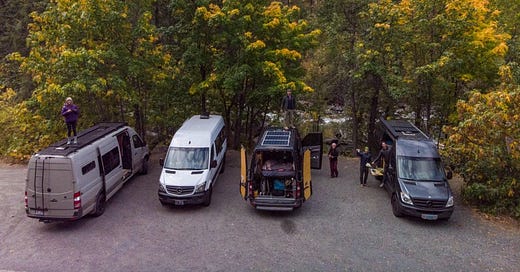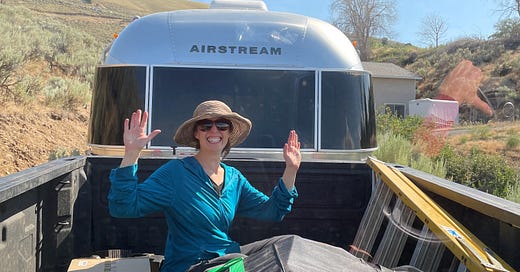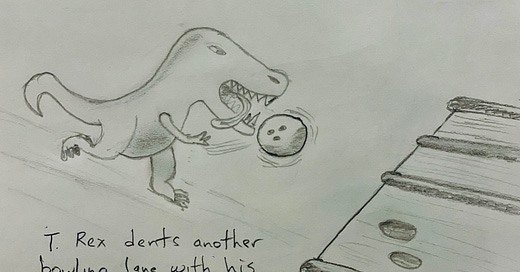
What I'd Change If I Built Out a New Camper Van
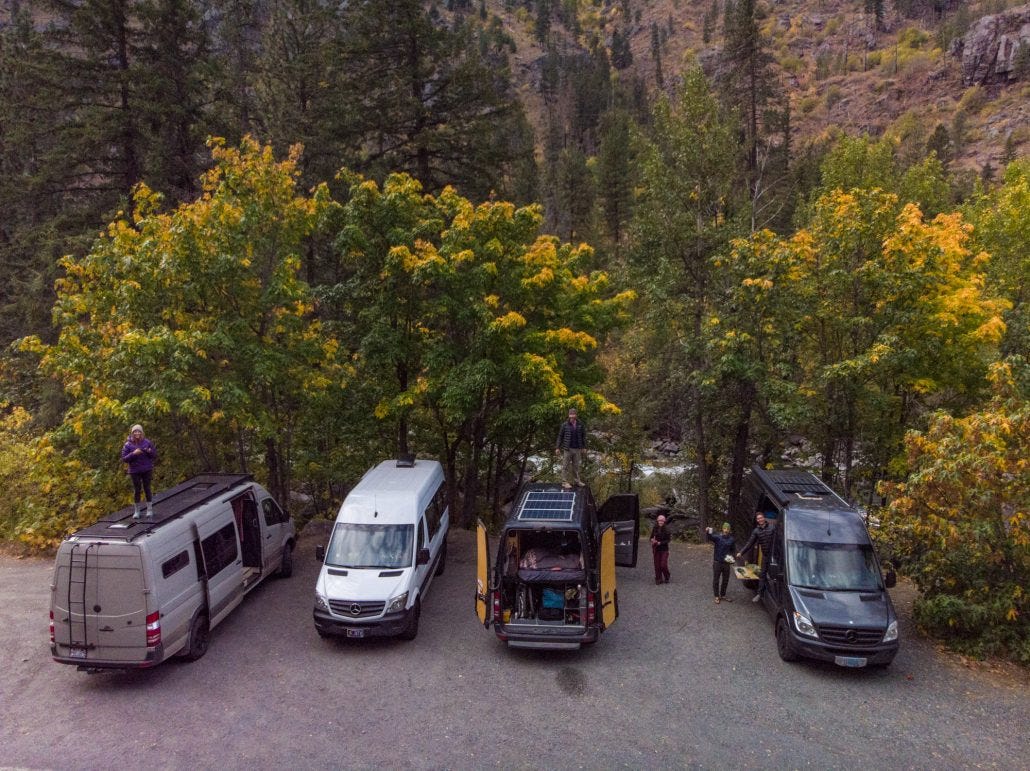
Good times in Leavenworth! (Pic: Kristen @bearfoottheory)
It appears this van life trend is sticking around. We’re sucking up wifi bandwidth at your library and stealth camping in your neighborhood...watch out! At most trailheads these days, I count the number of vehicles that aren’t vans.
I’m certainly not innocent. In fact, since I think all humans (and some dogs) need a van, let’s talk about how to make them Super Awesome Sauce. I've talked about my initial build, but never said "this still works" or "I'd change this."
While I currently don’t plan to buy a new van, reader feedback and many weeks of van travel this year prompted me to make a list of:
Things I still love about our van
Things I’d reconsider, modify or do differently if I endured...err, engaged in a new buildout project.
My aim is to help your quest to design the ultimate adventure mobile to retain the comforts of home while exploring places like this.
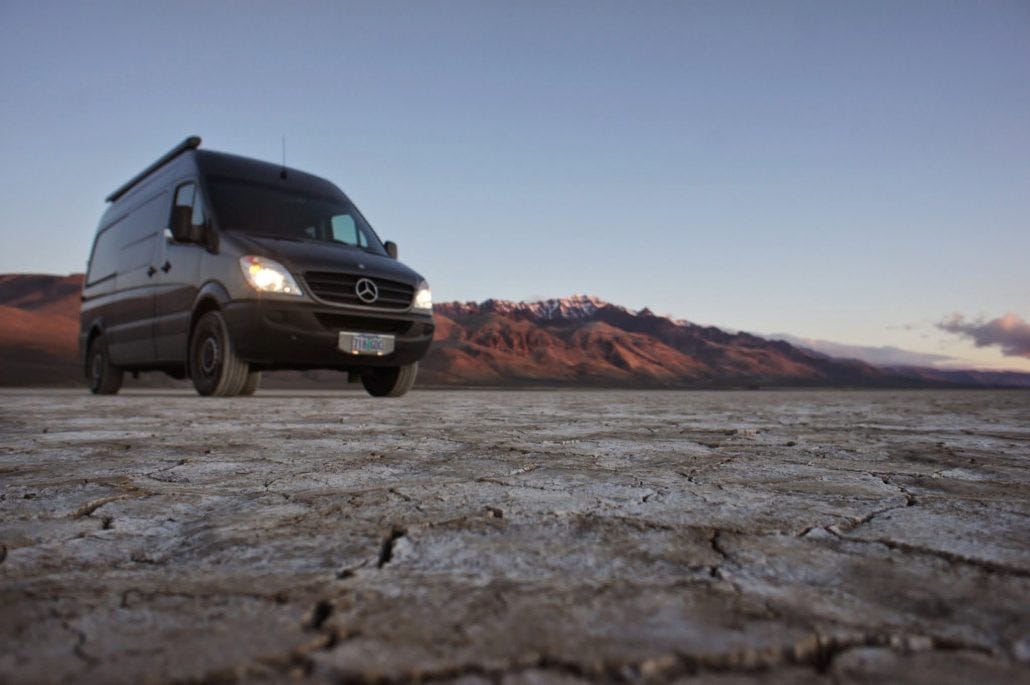
Sunrise on the Alvord Desert.
Why Should I Listen to You?
Hold on: why the heck does your opinion matter, Dakota? Do you even USE Snapchat? (Got me…)
Here’s all I’ve got: due to my writing about vans, I’m constantly awash in questions, comments, and thoughts about van life. Since 2013, my Adventure Mobile post has received hundreds of thousands of visitors and dozens of comments. (I’ve updated that article over 100 times with new info.)
I’m also lucky to have met many readers around the country during our travels. “Hey, I know your van...are you Dakota from Trapezing, Tripping, er Thrashing About?” (The name doesn’t matter, right? Next blog I’m using a word people know.) Trailheads, libraries, laundromats, grocery stores: Sprinter vans and their cool occupants are everywhere.
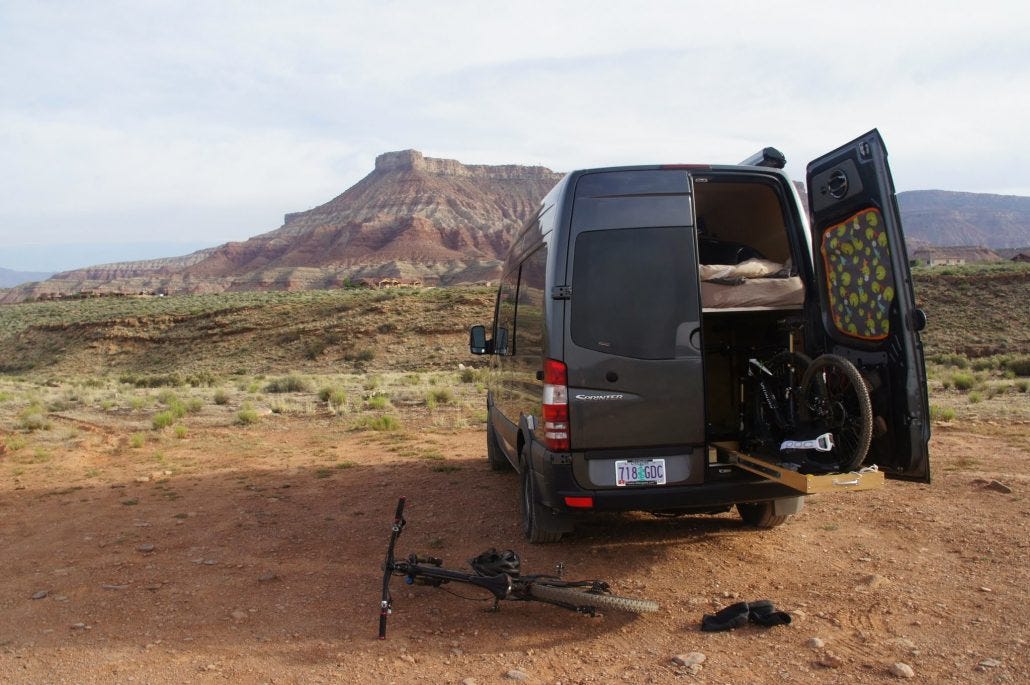
Van lifers everywhere except this empty trailhead in Utah. There's still solitude to be found!
Keep in mind that my goal for the van was a low-stress, relatively low-cost buildout that wouldn’t consume months of my life. I aimed for a practical, simple, cost-effective design doable with basic power tools and a bit of chutzpah (over-confidence). Five years into our relationship with the Sprinter, I still love the van travel experience.
First off, things I’d do again!
-----
By the way, dig these kinds of posts? Sign up for the free 2x/month Traipsing About newsletter for more tales from the mountains and creative challenges like drawing and piano when I'm off the bike or not van tripping.
I’d Do This Again If I Built Out Another Van
Buy the 144” high-roof Sprinter: I’m sticking to my guns on this one. The longer vans I’ve seen often leave more (wasted) interior space and are tougher to maneuver on the bumpy fire roads that I frequent. Throw in easier driving around cities and I vote for going shorter if you’re a couple with the standard van life hobbies of ride, run, ski, climb. (Caveat: if you have kids or travel with gear - e.g. dirt bikes - that need a separate gear garage, then a longer van may make sense.)
Bike racks on sliders: No better way to maximize space for vans that are hauling bikes. It also makes managing other gear easier. I vote for 2-3 slide-out drawers/storage to handle the entire gear compartment!
Big side windows on both sides: we love having the light and visibility from the CR Lawrence windows. Extra bonus is that the crank-out small windows allow great airflow when the vent fan is turned on.
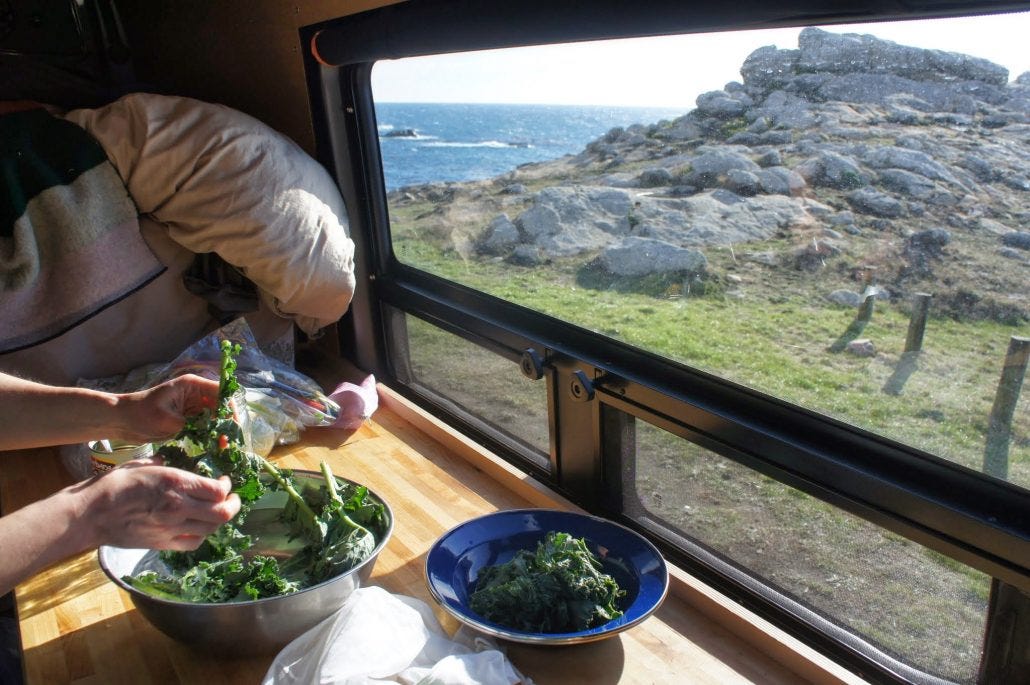
Lunch break with a view on the Oregon Coast.
Cabinet in sliding door space: I’ve heard the arguments here: space for yoga, you can sit on the stoop… Meh, sorry… The extra storage and counter space, plus the ability to have a sweet drop-down table for post-activity snacking with friends or easy food prep, beats the piss out of your downward dog pose. I vote for folding chairs and a mat outside the van for sitting and stretching. But that’s just me...
Large fridge: I’m sticking with a big, side-entry fridge (4.6 cubic feet). Having space for a ton of food is key for travel over a few days; for a weekender rig, maybe not so much.
Swivel seats: must-have for the passenger seat, but maybe not for driver. I traded my driver swivel to a friend for a bike rack, in fact, and haven’t missed it at all.
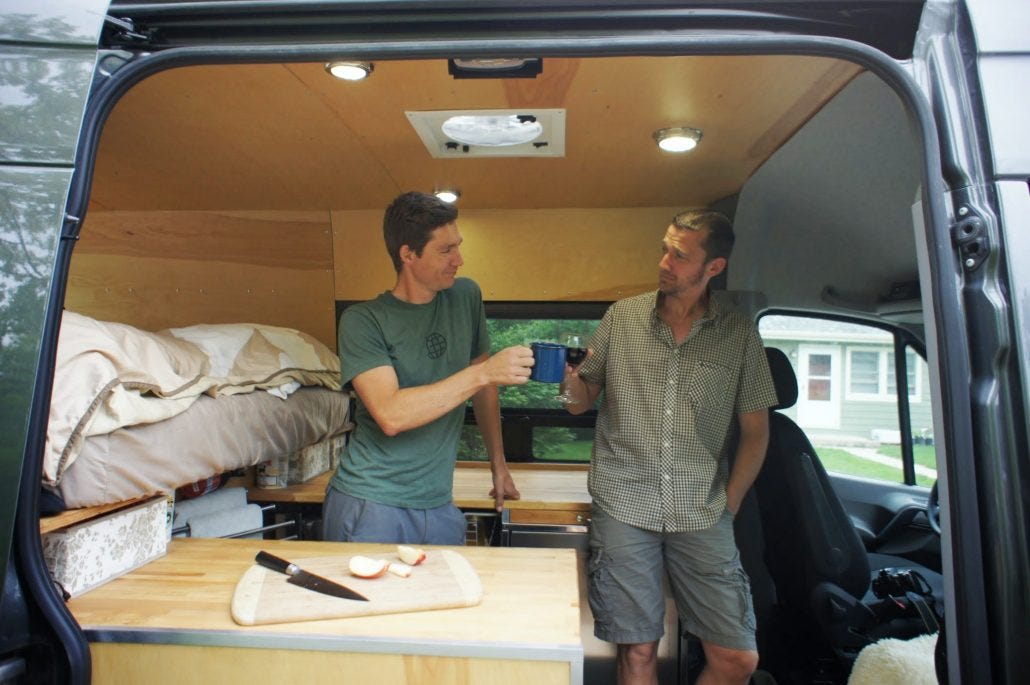
One swivel is fine! Mr. Money Mustache approves. (This shot's for you, Jules.)
Alternator wired to charge house batteries while driving: a must-have! Solar often isn’t enough to keep things fully charged, and just an hour of driving will top off most battery systems.
Update April 2021: things work slightly differently now, so check out my post on upgrading to Ohmmu lithium iron phosphate batteries and a Renogy DC-DC charger.
Diesel heater: unless you only travel in the summer at low elevation, this is a key component of any van build. I still stick by what I said in my install post: "With 20/20 hindsight and many sub-freezing nights logged, it is officially one of our favorite things in the van." Given feedback from others, it seems worth it to get the high-altitude kit, though our heater has worked fine.
Door-stop for sliding door: years into having this on our van, we still love it! My brother-in-law Jesse continues to manufacture and ship these and has a ton of satisfied customers.
Drop-down side table: as I said in my favorite upgrades post, this is so handy for cooking or food prep, putting out snacks post-ride for friends, and general staging area for all activities.
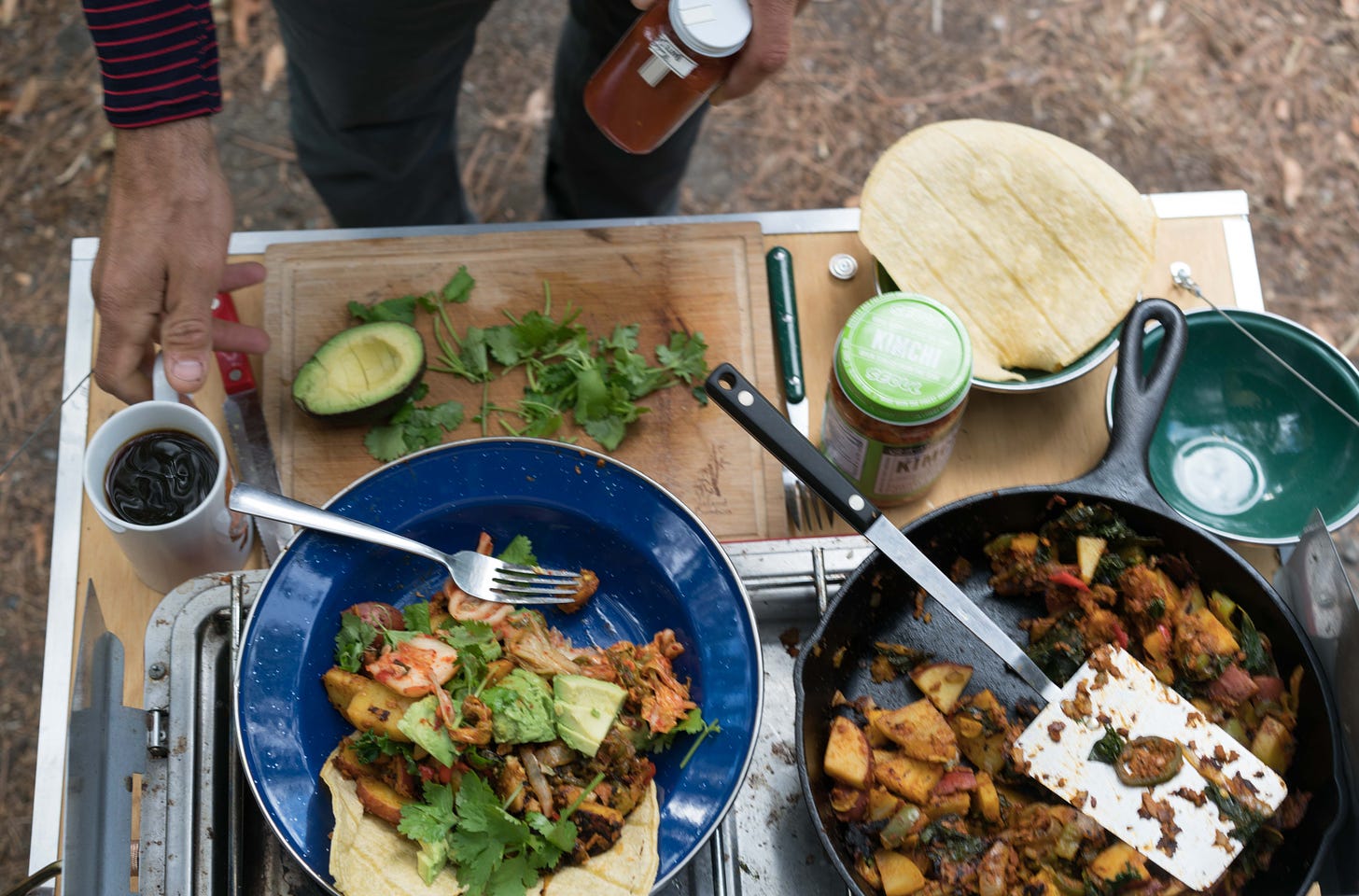
Breakfast a la side table!
Solar: not mandatory if your batteries charge while driving, but still handy. Given how cheap they are now, putting solar panels on a van is practically a no-brainer these days!
WeBoost wifi extender: if you work while you travel, this handy device is destined to be your best buddy. It’s not a magic device that turns No Service into LTE bars, but often allows me to stay parked way out in nature and still get enough of a signal to check email without driving somewhere. We have the WeBoost Drive 4G-X, which ain't cheap, but it's worth it for us!
Propane hot water shower: I wish I’d done this earlier! For $100 and two hours of plumbing, a hot water shower off the back of the van is an easy upgrade totally worth doing. I bought an Eccotemp L5 heater as an open-box deal, but they're on Amazon also if none are available.
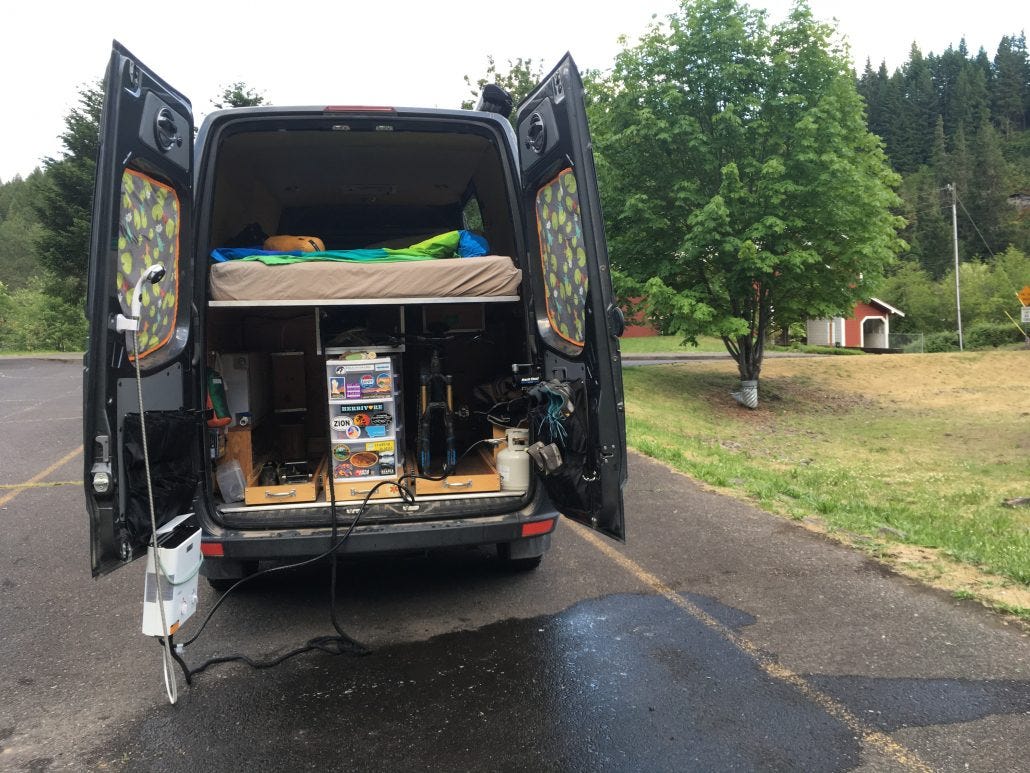
Hot water rinse after a long, awesome ride in Oakridge (full ATCA, no shuttle!).
Things I’d Do Differently
There’s all the stuff I’d keep. What would I change? With the benefit of many months traveling in the van, both for short and long trips, I’d make these modifications:
No rear windows: The way our design evolved, only the top section of our rear windows are usable. (Most designs with bikes or outdoor gear under the bed will end up like this.) If I did it again, I’d skip the rear windows and install a small port window above the bed.
More power: related to the next item, instead of ~200 amp-hours of battery power, I’d double it to 400 amp-hours via lithium-ion batteries. Update April 2021: 300 Ah is plenty of power given lithium's ability to drain to 10%. Full upgrade post here. This provides a week of power with zero driving or solar, which is when a) I’ve eaten all the food and we need to restock or b) it’s time for new horizons (because we’re moving on, not due to police suggestion).
No shore (plug-in) power: In four years of ownership, we’ve only used the shore power a handful of times. I wouldn’t bother next time. With 400 amp-hours of power, you definitely won’t need it unless you’re planning to pay for electrical hookups and run A/C in a KOA campground...which is antithetical to van life, so you may need to just buy an RV or risk community shunning!
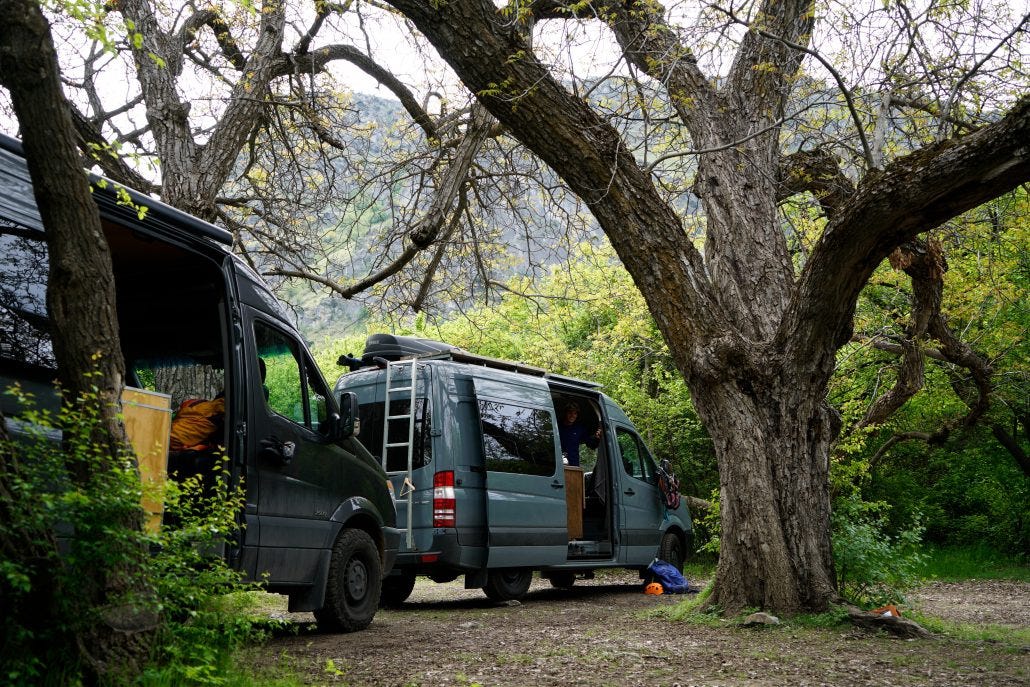
No shore power in the free waterfront campgrounds in Hell's Canyon. Rock climbing just steps away in those hills!
Easily washable floor: Due to time constraints before our trip, we kept the stock floor that came with our van. It’s served us well. Still, I wish we’d had the time to put in a swath of colorful Marmoleum to create a durable, fun, more easily washable floor.
Less sound deadening: The stock Sprinters, ProMasters and Transits suffer from vibration and sound transfer. Bare metal walls create an echo chamber worse than my nephew destroying his drum kit. (Ok, maybe that isn’t possible.)
I’m glad I used sound-absorbent material below the floor to limit road noise. I’m less sure about the vibration damping for the walls and ceiling - after insulation and interior paneling, half as much is probably fine. Thanks to the heavy damping in our sliding door, it is a shoulder-breaker on slight uphills. If I did it again, I’d put pieces of vibration damping in there, but not coat the entire door.
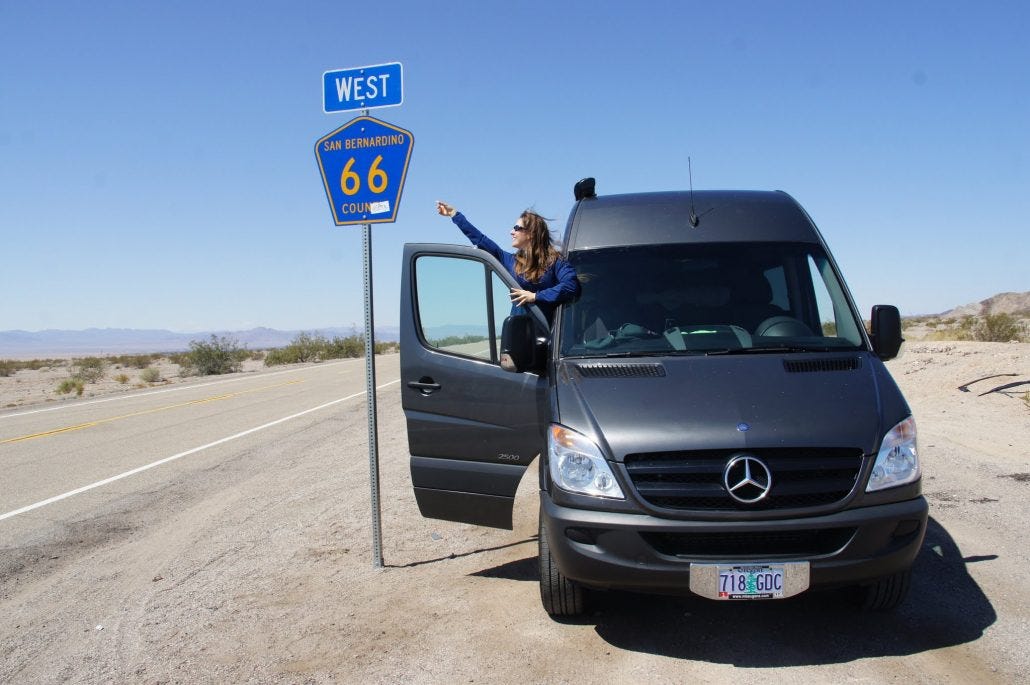
Going wayyy back on Route 66.
Modular storage tray: We don’t always carry four bikes, which means one tray isn’t used or is under-used, especially for shorter trips of 1-4 weeks. I'm planning to make a modular/removable rack for carrying climbing gear, skis, paddles, or whaaatever.
Design for fitting skis: We weren’t skiers in 2013, so the separation wall between the storage and the living area doesn’t allow for long skis. Some simple mods to cabinets would allow this.
Wire/plumb initially: Not knowing exactly how we’d use our van, we didn’t plumb or wire before most of the interior was installed. I put in overhead lights halfway down the CA coast, and sink plumbing didn’t happen until 2.5 years of traveling in our van. (Chelsea is tough!)
If you have the time and confidence in how you’ll use your van, map out as much of this stuff as possible. Given the in-depth resources, floor plans, and designs now kicking around the ‘nets, this is way easier now.
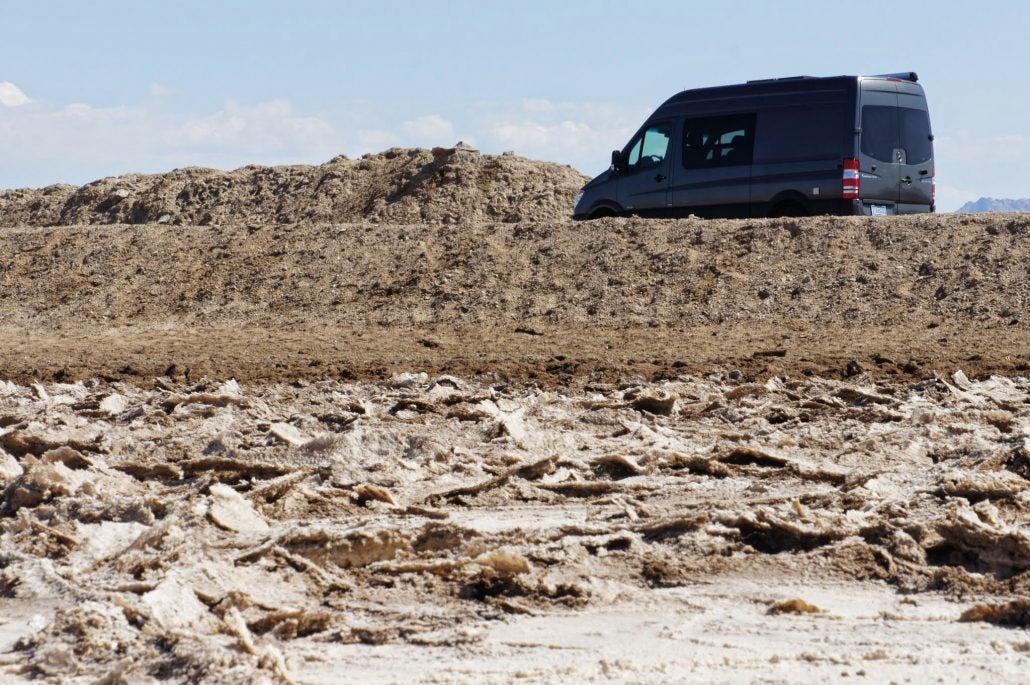
Good to have extra water when you're in the Mojave!
Backup camera: I can parallel park the van like a boss. However, the visibility is limited and stress levels are lower in crowded parking lots or kids playgrounds if you’ve got a backup camera. I’ve only bumped a stealth motorcycle behind us once (it didn’t tip over). Update fall 2019: I bought a cheap license plate surround backup camera and it's been great!
Insulated blackout curtain: New desire: an insulated curtain that snaps up to seal off the cab from the main living compartment for insulation and easy light blocking. It’s also a good way to look innocent while stealth camping, if we ever did that…
Skip the awning: This one came as a surprise. I pictured sunny afternoons lounging under an awning, fizzy water from the Sodastream in one hand and a book in the other. It rarely worked out that way. Usually, there was a tree for shade, or gusting wind turned the awning into a large kite, or we weren’t in one place long enough to set it up. Plus it’s worse for gas mileage. Geez, I might go put it on Craigslist now!
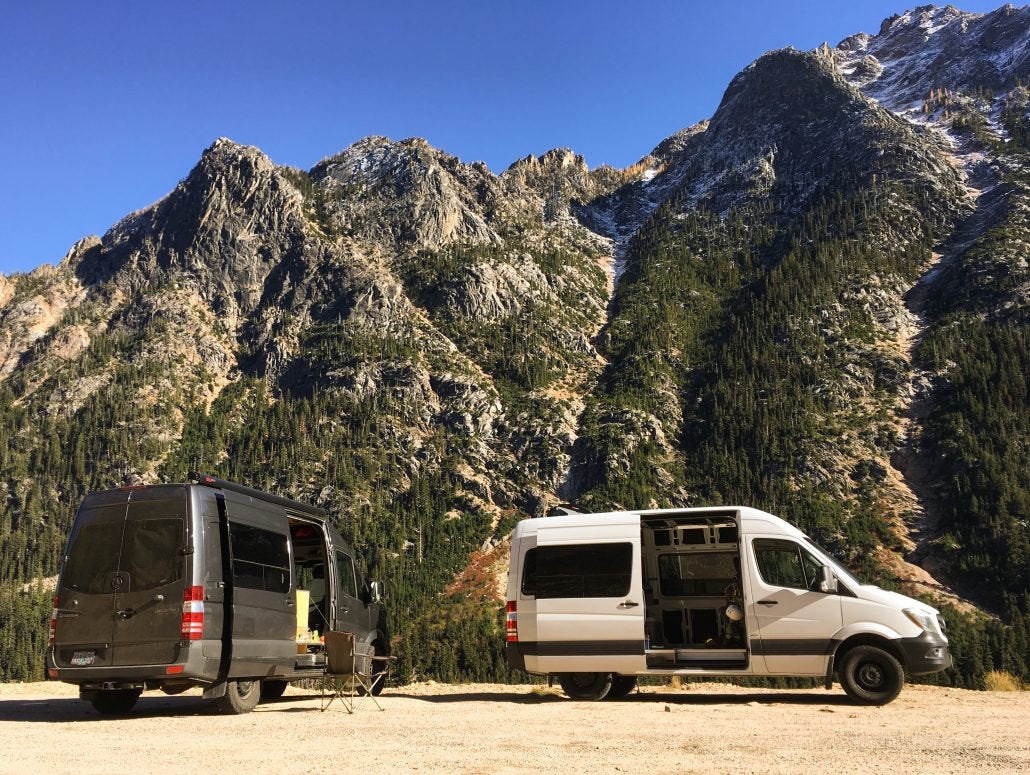
No awning needed during a lunch break in Washington Pass.
Maybe I’d Add These
Here are a few items I’d consider if I was feeling flush with skrilla and planned on living in a van long term:
Flares: One downside to the Sprinter vs. other vans (ProMasters, Transits) is that they taper toward the roof. This results in a width that isn’t sufficient to sleep crosswise. Flares, while still expensive ($2k/each installed), free up space in the van and (maybe) are worth it.
Buy a 4x4: everyone wants a 4x4 these days. While I think this is at least 30-80% because they look bold and badass, there is certainly utility in owning a 4x4 if you spend a lot of time skiing. However, I know tons of folks that ski all over in 2WD rigs with no issues. All in all, I think vans are not meant for rallying and that 4x4s just get you stuck further out.
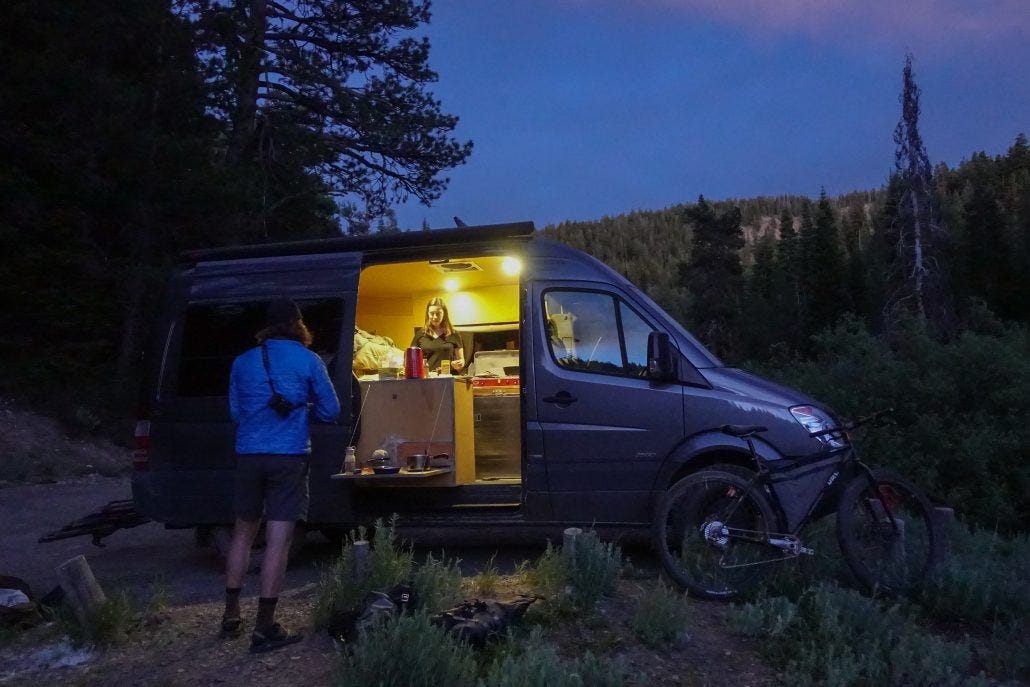
The rough roads on the way to the start of the Oregon Timber Trail were no problemo in my 2WD mobster van!
Cabinet over our sink: We have tons of storage space in the cabin, but an overhead cabinet would spread things out. The con is that it feels tighter/borderline claustrophobic and Chelsea is a big thumbs down on upper cabinets. Van lifers often comment how open our van feels. Trade-offs! For the shorter trips we’re doing now, upper cabinets don’t feel necessary. For four-season, full-time travel, probably worth it.
Hydronic hot water: I’d give this some serious consideration next time around. From what I’ve heard, the aftermarket hydronic systems are excellent. Still, it’s an expensive, fairly complicated system, and our hot water boiler and propane on-demand shower work great. Maybe someday...
Diesel or induction cooktop: The magic of flipping on a burner without having to setup the stove is not overrated. (Weird, it’s like amenities from home are nice to have in a van!) However, it’s great to have the flexibility to cook inside, on the slider door dropdown table, or on a picnic table.

What it's all about! (Well, other than the outdoor adventures, exploring awesome places, meeting new people...)
No Matter What You Do, Vans Are Awesome
All that said, if there’s anything I’ve learned in five years involved in the world of van life, it’s this: a basic setup is all you need. Put a bed (or sleeping pad!, plastic lantern, cooler and outdoor gear in ANY vehicle and you’re equipped to experience all the stuff folks in $100k van builds do.
Case in point: Today an employee at a local bike shop told me she spent $72 on zipties and crates for her van build. Then she went dreamy-eyed and talked about a recent, amazing five-month trip. This past weekend at a van meetup, a dude named Andrew showed me his basic setup that allows him to roam the United States working as an artist.
Don’t feel like an expensive build is the only way to go; there are many ways to explore the world. Power in simplicity!
All you van owners out there - what would you add to this list? Every van and its use are different, so it’s always fun to hear what folks think. Drop a line in the comments!

Van life meetup last week in Bend with a big crew. Always fun hanging with blog readers!
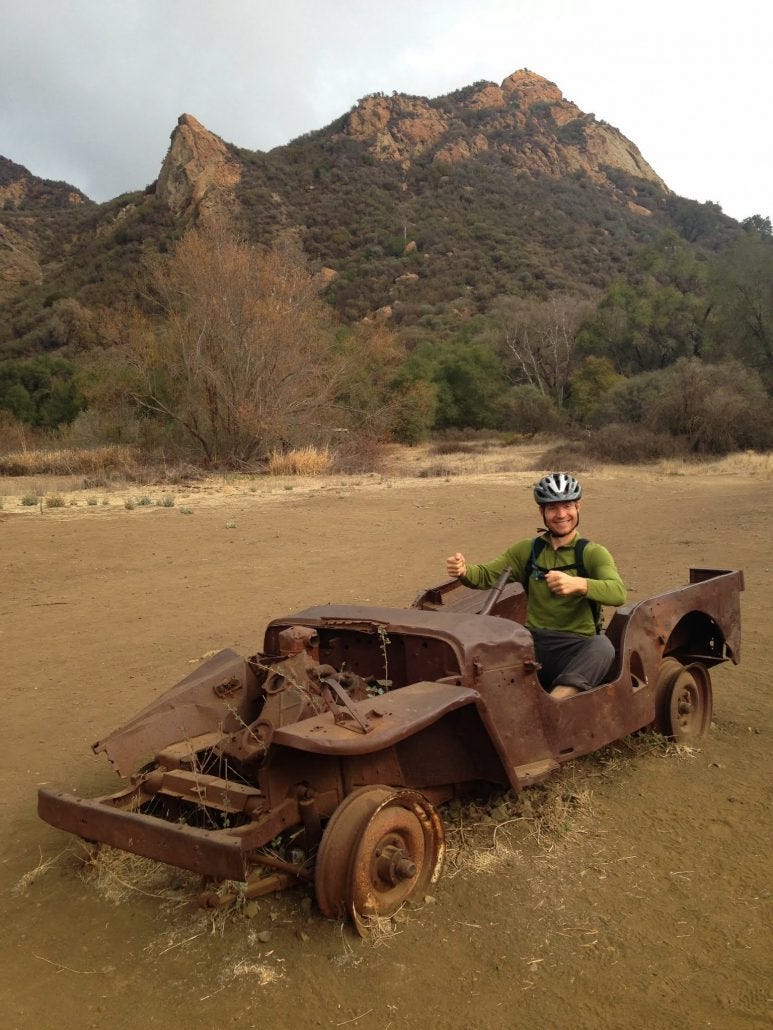
Any old vehicle works as an adventure rig... Suspension is a bit rough on this beast, but it gets the job done.

